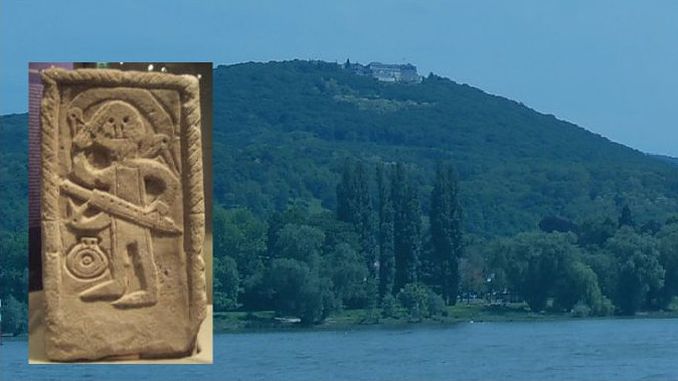
Ar the time of the Kingdom of the Franks, under the Merovingians and Carolingians, the first villages in the Siebengebirge came into being.
At the beginning of the 5th century, two groups of Franks had emerged: the Salian Franks lived at Tournai, Cambrai and Arras, today’s Belgium and northern France, back then part of the Western Roman Empire.
They fought as allies (foederati) in the Roman army. Their kings were high-ranking officers in the Western Roman army. Here we meet the first Frankish Royal dynasty, the Merovingians. The first Merovingian king that we know by name is Childeric I. He was a senior officer in the Roman army and fought it for the last Roman governor Aegidius.
The Ripuarian Franks on the right side of the Rhine were enemies of the Empire and had conquered Roman Cologne.
Clovis
Under Childeric’s son Clovis, the Frankish Empire became a European power. He was baptized and took the Catholic confession. According to the “Historia Francorum” by Gregory of Tours, Clovis had invoked the Christian God to give him victory in the almost lost battle of Zülpich 496 victory over the Alamanni. Nonetheless, his decision was above all a shrewd political move. By choosing the Catholic confession, he had chosen the religion of his Gallo-Roman population; therefore they would support his kingdom. On the other hand, Clovis did not lead a Christian life, he remained a Germanic warrior king.
Clovis’ reign stands at the transition from Late Antiquity to the Middle Ages. That is to say, Roman conception of the state, Catholic Christianity and Germanic military kingship melted in his kingdom.
But already in the generation of his sons, the decline of the Merovingian Empire began. Eventually, his grandsons divided it. Neustria (now western France, capital cities Paris and Soissons), Austrasia (regions at the Rhine, Meuse and Moselle, Champagne, capital cities Reims and Metz) and Burgundy (Loire and Rhone River basin, capital Orléans) came into being. Back then, our region was situated at the eastern border of the Frankish Empire.
Many years later, Chlotar II (584-629) reunited the Merovingian Empire. But he had to make far-reaching concessions to the dukes, as a result in Bavaria, Alemannia and Aquitaine mighty dukedoms came into being. Austrasia and Neustria obtained administrative autonomy; Burgundy got lost. Clothar II and his son Dagobert I “the Good” are considered the last great Merovingian kings. But already in their time their highest government officials, the Mayor Domus, had firmly established their position.
Back then in the Siebengebirge
At the time of the Kingdom of the Franks, various villages around the Siebengebirge came into being whose names tell us a lot. Names that end on “-heim” or “-dorf” indicate the oldest Frankish settlements, whereas names ending on “-hofen” and “-inghoven” indicate younger ones. Names that end on “-rott” or “-roth” indicate villages that came into being after clearing parts of the forests (“roden” in German). Other names give a hint on the location. Village names that end on “-berg” (mountain) refer to villages in the mountains. Names that end on “-bach” (stream) indicate that the village is close to a stream. For instance, the name Oberpleis refers to the nearby Pleisbach creek.
One of the first settlements in the Siebengebirge was Niederdollendorf; here a Frankish gravestone from the 7th Century has been found. Today we can see at Rheinisches Landesmuseum, Bonn. It shows Christian and Pagan elements. Back then, Christianity was mixed with Pagan beliefs, and often priests were killed.
The rise of the Carolingians
With the decline of the Merovingian dynasty, their Mayor Domus from the Carolingian family became mighty men. Charles Martel, who defeated the Arabs in the Battle of Tours and Poitiers 732, reigned like a king. Pepin III then did away with the Merovingian shadowy kingdom. In 751, he had himself crowned with the consent of the pope. A deal both sides profited from, as with the “Donation of Pepin”, the Papal States came into being.
Charlemagne
Under his son Charlemagne (768-814), the Frankish Empire rose to be a European power. Driven by an enormous will for power and often with merciless rigor, Charlemagne rearranged things in his spirit. He fought the Saxons, the Lombards, and the Moors. Then he divided the empire into counties, these again in districts (Gaue). At the top was a count whom Charlemagne himself appointed, transferred and dismissed.
On Christmas Day 800, Charlemagne was crowned emperor by Pope Leo III. in Rome. Now he was, in the tradition of the Christian Roman emperors, the protector of Rome and the Church, and his Frankish Empire was the successor kingdom of the Roman Empire. Both cultures, the Christian-Roman and Frankish, should sustain the Empire.
Charlemagne took care of the education that had been down for a long time already. He kept reminding the clergy, in his time a key source of education, to learn Latin and Greek, and to study the sciences. He called highly educated men to his court in Aachen, the “Hofschule” came into being to which we owe wonderful book illuminations. At the same time, Frankish was spoken at court and in the churches as well.
The Auelgau
In the Kingdom of the Franks, the Siebengebirge were part of the county “Auelgau”. A document from the year 893 mentions a village named “vintre”, that goes back to the Latin word for vineyard. Obviously, the Siebengebirge was a vine region already back then. In late Carolingian times, the villages Oberdollendorf and Römlinghoven came into being.
The partitions
At that time, Charlemagne’s grandsons had divided his empire among them. Lothar I reigned in the Middle Empire, Louis II “the German” in the eastern empire, and Charles II “the Bald” in the western empire. The Rhineland was part of Lothar’s kingdom, Lotharingia.
But the middle empire did not last. Already in 870, in the Treaty of Meersen, Charles the Bald and Louis II divided it among them. Now the Rhine was the border, the left bank of Lotharingia was part of the Western Empire, the right bank was part of the Eastern Empire. In the treaty of Ribemont 880, the East Frankish King Louis III could win also the western part of Lotharingia.
In 881, the Normans raided the Frankish kingdom and devastated Cologne.
A look beyond the Rhineland
Anglo-Saxon England (597-1066). At that time, Anglo-Saxon and Irish monks were proselytizing in the Frankish Empire. The first was the Irishman Columbanus who founded the monasteries of Luxeuil and Anngray in today’s France and Bobbio in Italy. The “Apostle of the Germans” was then the British Boniface, who began his mission in 722. He brought the church under the authority of the Pope in Rome.
References
The following pictues are from the German Wikipedia.
Das Bild der Grabstele von Niederdollendorf von Hans Weingartz, Leonce49 (Urheber) stammt aus der freien Enzyklopädie Wikipedia; CC-BY-SA-3.0-DE und steht unter der Creative Commons Lizenz 3.0.
Das Bild Petersberg von Bad Godesberg stammt aus der Public Domain Section der Wikipedia.

Be the first to comment